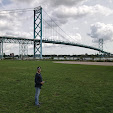Located about halfway between Baton Rouge and
Vicksburg near the city of Natchez, the Natchez-Vidalia Bridge crosses the
lower Mississippi River between southwest Mississippi and northeastern
Louisiana at the city of Vidalia. This river crossing is a dual span, which
creates an interesting visual effect that is atypical on the Mississippi River
in general.
Construction on the original bridge took place in the late 1930s in conjunction with a much larger parallel effort by the U.S. Army Corps of Engineers to strengthen the area’s flood protection and levee system along the Mississippi River. One of the more ambitious aspects of this plan was to relocate the city of Vidalia to a location of higher ground about one mile downriver from the original settlement. The redirection of the river through the Natchez Gorge (which necessitated the relocation of the town) and the reconstruction of the river’s levee system in the area were undertaken in the aftermath of the Great Flood of 1927, which devastated communities and farmland all throughout the Mississippi Delta region. In response to this disaster, the federal government passed the Flood Control Act of 1928, which gave absolute power to the U.S. Army Corps of Engineers to design and maintain a flood protection & levee system for the Mississippi River. The elimination of a prominent oxbow bend in the river across from the Natchez Gorge and the associated relocation of the city of Vidalia was one of the largest projects undertaken by the Corps in the 1930s as part of the larger risk-reduction effort along the lower Mississippi River.

The dual spans of the Natchez-Vidalia Bridge reflect 50 years of engineering progress in design and construction of bridges along the lower Mississippi River.
The new bridge connected the new city of Vidalia
with the old river town of Natchez when it opened in 1940. Over the years, the
bridge became important as a linchpin in the region’s US Highway system, even
in the years following the creation of the interstate highway system and the
original bridge’s narrow roadway (its travel lanes were reported to be as narrow
as 8 ft and the bridge’s roadways lacked shoulders or other safety measures).
Traffic demands in the area warranted the construction of a parallel span,
which opened to traffic in 1988. Under the current configuration, westbound
traffic crosses on the original 1940 bridge while eastbound traffic crosses on
the new bridge. The parallel span was built wider than its predecessor and
features modern shoulders and standard-width travel lanes. Both spans were
built to similar proportions and appear to be identical on first glance. Each structure
is about 4,200 ft long from abutment to abutment and they feature steel truss
superstructures over ½ mile in length. The four cantilever bridge towers are
the focal points that support the three longest spans of the superstructure,
each about 850 ft long. The roadways stand upwards of 125 ft above mean river
level, making them the tallest bridges in the state of Mississippi.
This bridge is located near a significant crossroads of the US highway system, one of the more robust such locations in the deep south. When the first span of the bridge opened in 1940, it was part of US Highways 65 and 84 and these two highways have been most closely associated with the bridge over the years. As of 2024, the bridge carries US Highways 84 and 425 and is located near prominent intersections with US Highways 61, 65, and 98. US 65 crossed the Mississippi River on this bridge until 2005 when its southern terminus was relocated to Clayton, LA. At around the same time, US 425 was extended eastward over the Mississippi River to end at US 61 in Natchez. US 98 begins at US 61 on the north side of Natchez, a short distance from the eastern bridge approach.
Further Reading:
Natchez-Vidalia Bridge by John Weeks
Natchez-Vidalia Bridge at historicbridges.org
Bridges, Crossings, and Structures of the Lower Mississippi River
Next Crossing upriver: Vicksburg Bridge (Vicksburg, MS)
Next Crossing downriver: John James Audubon Bridge (New Roads, LA)
Nearby Flood Control Structure: Old River Control Structure (Lettsworth, LA)
Return to the Bridges of the Lower Mississippi River Home Page
__________________________________________________






























































Comments